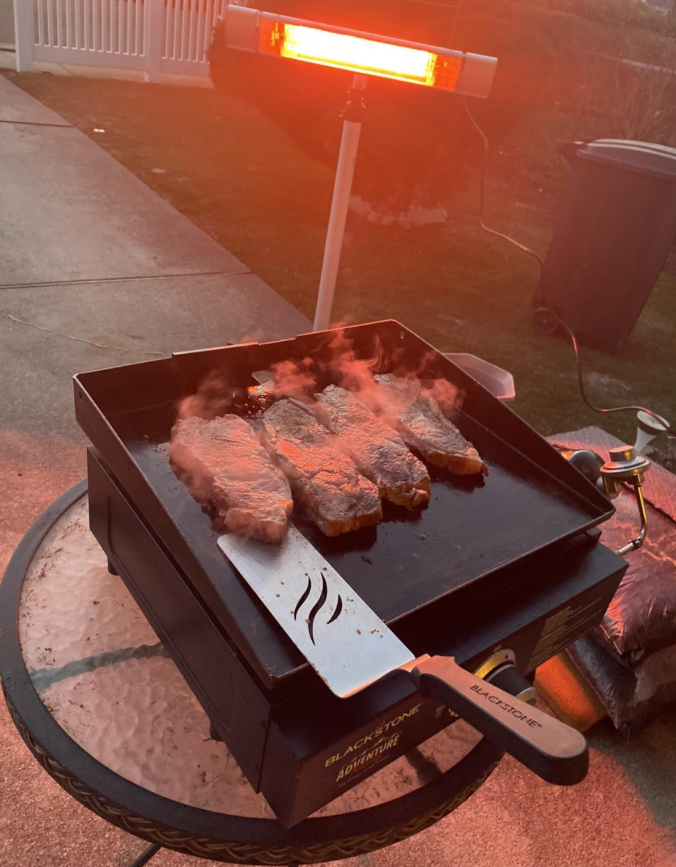Grilling in the cold is different than grilling when it’s hot outside. Maintaining high cooking temperatures in spite of wind, rain, and snow can be quite challenging. Here are the top expert tips we’ve collected:
PLAN AHEAD
Grilling in the winter will require more fuel (coal or propane) and time than it does in warmer months. Plan on about 50% more fuel—just to be on the safe side—and a slower cook time. You don’t want to be caught without fuel before your chicken is done cooking, and you don’t want everyone to be hungry with dinner not yet ready.
It’s worth noting that hardwood lump charcoal burns hotter than charcoal briquettes and is a good option when you’re working in freezing temperatures.
CLEAR A PATH
It’s important to have a path that is free of snow and ice not just to access your grill, but to stay safe. There’s always a bit of risk involved when you’re grilling outdoors, but slips and falls increase that risk.
And don’t grill under an overhang or in a barn or garage! It may seem easier to set up in the garage than shovel out that path, but it’s far too dangerous. You don’t want to burn your garage (or house) down for the sake of a fresh burger.
BUNDLE UP
Be sure you’re warm enough to spend some time outside in freezing temperatures, but don’t wear any loose clothing that could possibly catch fire. Close-fitting layers are your friends!
Wear your heat-resistant grilling gloves for cooking, not your ski gloves. They’ll get ruined by the grease and possibly the heat of the grill.
SHIELD YOUR GRILL FROM WIND AND PRECIPITATION
Rain and snow that fall on your grill quickly wick away heat through evaporative cooling. The more your grill’s temperature is cooled down by wind and precipitation, the more fuel you will use.
EVERYTHING IN ITS PLACE
Have everything prepped ahead of time to minimize your time outdoors. Have your meat, seasonings, tongs, thermometer, foil for wrapping, warm platter, or anything else you might need ready to go so you don’t have to open the lid multiple times or run back inside to grab something you forgot.
BE SURE THE COOKING AREA IS WELL LIT
Days are shorter in the winter so you may be working in the dark if you’re grilling for dinner. Use your porch lights, have a flashlight handy.
KEEP THE LID CLOSED
Every time you open your grill’s lid cold air can rush inside, cooling down your grill and slowing cooking time.
Even when searing, the added warmth of the ambient air in the grill will really help the cooking. Keep the lid closed as often as you can.
COOK TO TEMPERATURE, USE AN INSTANT-READ THERMOMETER
Estimated cooking times in recipes will not be the same when you’re grilling in the winter. The only way to know if your meat is done cooking is by taking accurate temperatures. Use a fast and accurate thermometer you can trust. The faster the thermometer, the less time you need to have the lid of your grill open and venting heat.
Not only is an instant read better for keeping the heat in, it’s also kind of the only option! The high temperatures of grilling exceed what an alarm thermometer’s probe cable can handle. The best temperature tool for high-heat cooking applications is an instant-read. Read the article The Difference Between BBQ and Grilling for more information on the important temperature differences.
KEEP YOUR FOOD WARM
Once the food is done you’ll want to keep it warm on its way indoors. Cast iron retains heat extremely well. Heat up a cast iron skillet or dutch oven to transport your grilled food from the grill indoors. Keep the cast iron on your grill while cooking if you have room. It’ll make bringing the food inside easier. If you don’t have room on the grill you can warm it up in your oven.
CHOOSE SIMPLE RECIPES AND GRILL WHAT YOU KNOW
If you can help it, keep flipping, basting, and moving-around to a minimum.
Just one flip may be an extreme goal, but the idea holds. If you can get in, get it done, and get to table with a minimum of fuss but a maximum of flavor, do it! Boneless, skinless chicken thighs are great for this, burgers, brats…this just might not be the time for multi-stage, temperature-varying cooks.
Also, a freezing environment is not one where you should be trying new things out. Cook what you know in the winter, expand your repertoire during summer. You don’t want to be futzing with a new recipe in this weather!
TIPS FOR COOKING WITH GAS GRILLS IN COLD WEATHER
GRILL CHECK
If using a gas grill, perform a quick grill check. Check to see if there are any leaking cracks in the hoses, if there are, replace them. Check to see if the lid or any knobs are frozen. If they are you can use a hairdryer to gently melt the ice. Don’t force anything to turn or open.
FUEL TANK PRESSURE
As the temperature outside decreases so does the pressure in your fuel tank. A partially full tank may not have adequate pressure to keep the grill lit. A full tank will have better pressure, so it might be worth filling up.
There’s something extra satisfying about braving sub-freezing temperatures to cook outdoors. Is it the taste of summer in the long dark nights? is it the sense of victory and defiance against the elements? Whatever the reason, grilling through the winter is a great idea. Just keep these tips handy and be confident with your grilling projects 365 days a year!
